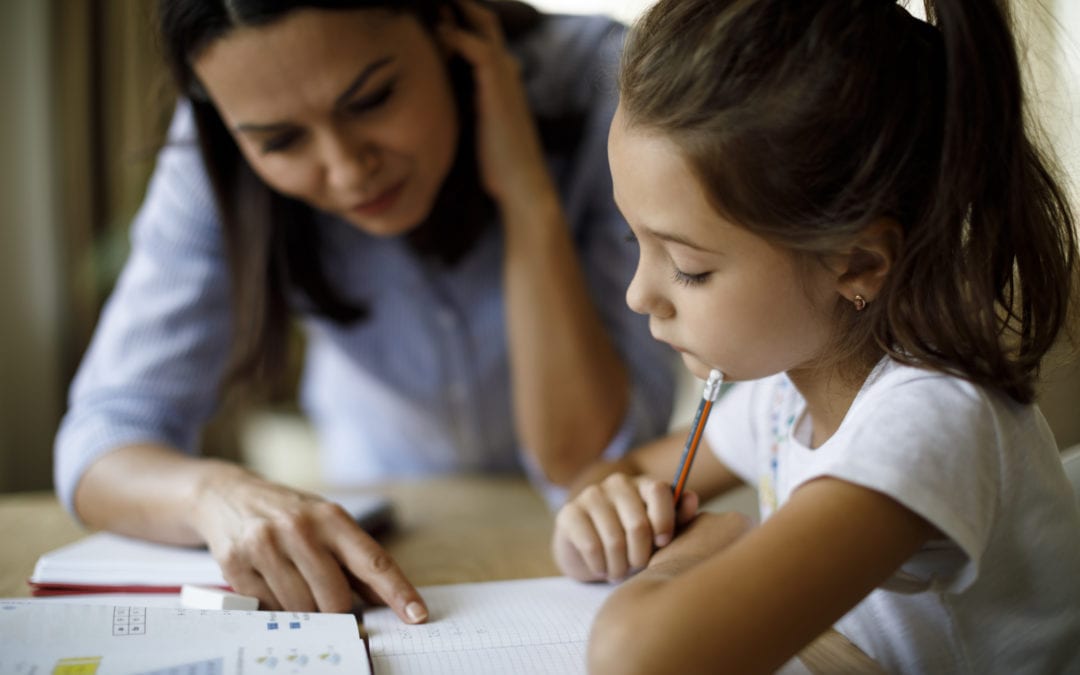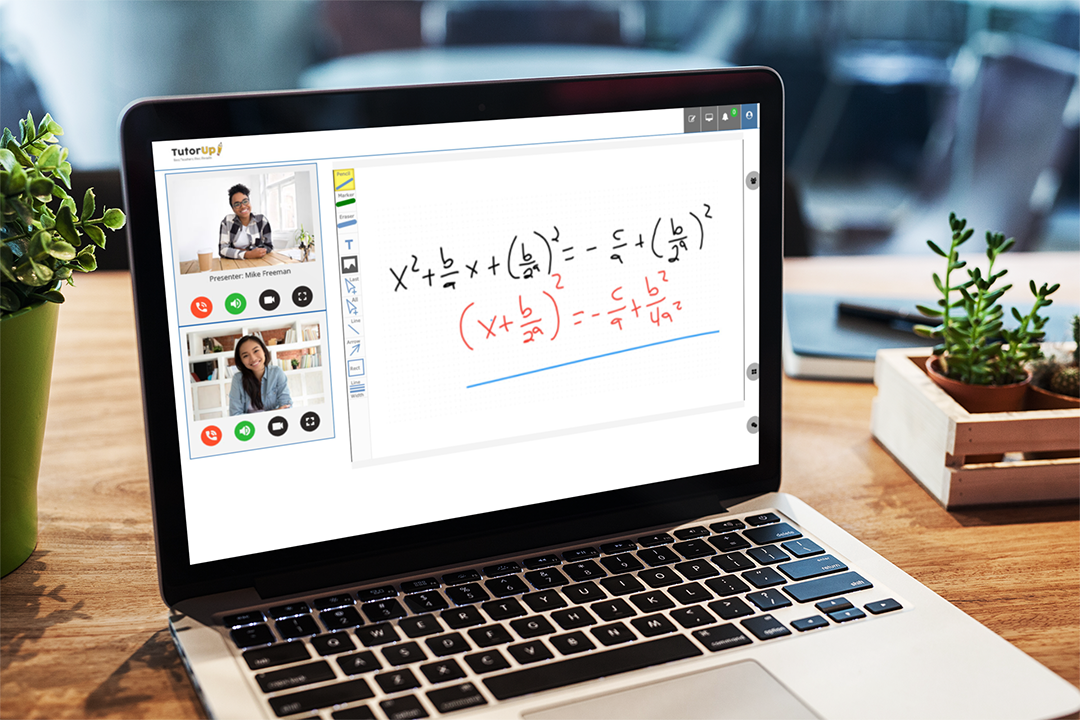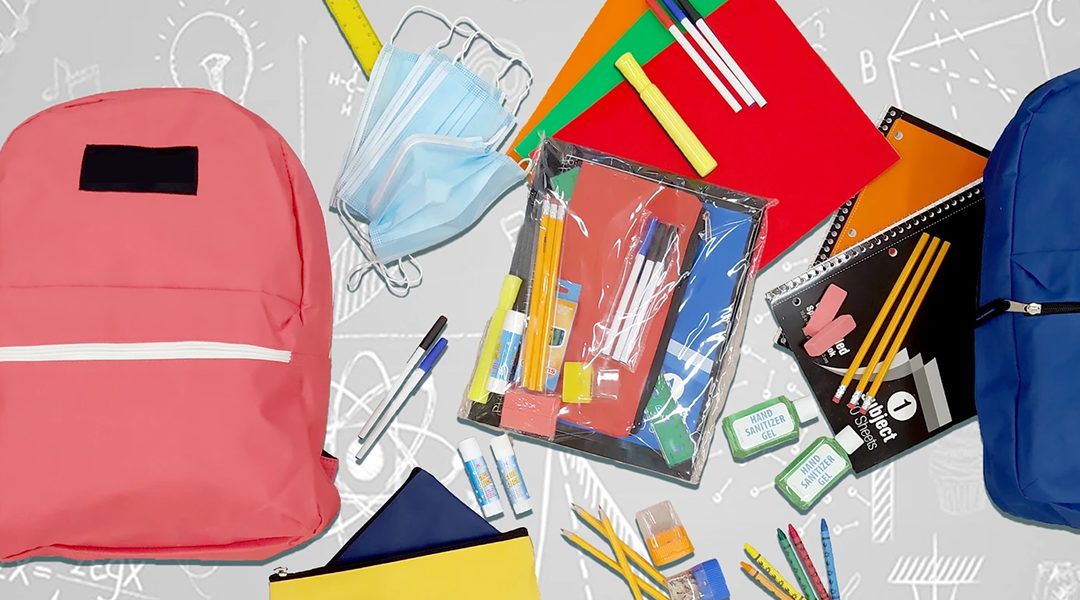
by TutorUp | Oct 2, 2020 | Parents and Home
The 2020 school year so far has seen unprecedented challenges and lots of upheaval. The teachers we talk to have shared their own individual experiences and they run the gamut. Some are back in school full-time, some are holding virtual classes online, or a hybrid blend of the two, and many have decided to sit out this school year in favor of staying home to work with students one-on-one in private tutoring.
The parents we talk to need help dealing with the huge increase in homework combined with the lack of attention their students are experiencing. As parents struggle to manage work and home responsibilities, they are finding it difficult to also be proxy teachers to their kids. And all the while they are worried that their students are falling behind.
Change is Constant
With countless schools on lockdown to one degree or another all over the country, there is no universal plan for moving forward. Individual school districts, counties, and states all have varying levels of authority to decide what form instruction is taking this year and this has led to a lot of frustration for all concerned. Some schools have changed course once or twice already in the first month of school, having started in-person instruction only to revert to remote learning because of spikes in positive COVID-19 test results.
Just looking at the state of California, it’s obvious how chaotic the situation really is. Counties are moving from purple to red in the state’s four-tiered color coded tracking system. While the state has invested heavily in distance learning technology, gaps exist where many students just don’t have the access they need. In fact, parents have sued Los Angeles Unified school district over what they consider an “inadequate” plan for remote learning.
School districts in the Dallas area are still figuring out how they’re going to handle this school year. They’ve discussed using a hybrid model for nine weeks and then reevaluating. That means half of the students would go to school on Monday and Tuesday, have a “flex” day on Wednesday, and the other half would go to school on Thursday and Friday.
Teacher Shortages Force Last-Minute Changes
In New York, inadequate staff for in-person classes has led to schools being forced to quickly switch to remote learning. At one school, the change happened on the first day of school. In some cases, blended learning where students alternate between in-classroom time and online-from-home time has been implemented.
Colorado schools have announced that “we are in a crisis” due to their COVID teacher shortage. “Districts are getting creative,” said Amie Baca-Oehlert, president of the Colorado Education Association. “I’ve even seen districts asking parents if they want to consider getting a substitute license to help them fill the gap.”
The Tri-State area of Missouri, Iowa, and Illinois has reported a shortage of teachers and substitute teachers. As teachers are hesitant to head into the classroom, schools are finding that they are unable to find substitutes. And to add to the shortages, they are also having trouble finding reliable bus drivers.
Federal Funding to Help
In March, $13.2 billion of the CARES Act stimulus package was dedicated to K-12 schools. Continued tax revenue losses due to the COVID-19 shutdowns will have an ongoing negative impact on education funding. As a result, the House, the Senate, and the administration are currently in negotiations to pass another bill that would continue to help fund education, along with many other relief programs. Schools are asking for assistance in funding coronavirus school safety measures as these are additional operating costs that were unanticipated and unbudgeted.
Is There Any Positive News?
Regarding the coronavirus, a new study of COVID-19 in schools brings good news. As of September 25, there was a confirmed infection rate of 75 cases per 100,000 students and 140 cases per 100,000 staff members. That translates to 0.075% of children and 0.14% of staff. An associate professor of pediatrics at Johns Hopkins is quoted in the Washington Post’s coverage of the survey as saying, “We’re not seeing schools as crucibles for onward transmission. It’s reasonable to say that it looks promising at this point.”
Governor Charlie Baker of Massachusetts reports that the back-to-school season “is off to a fine start” as they focus on the importance of in-person learning in communities with low COVID-19 risks. Assistant superintendent Erin Perkins said the challenges of bringing students and staff back into school buildings were made worth it by “the way children lit up as they entered the room.”
On the community level, the Trees for Cities charitable organization is urging teachers and parents to help children embrace outdoor learning at home or school. They are providing free online educational resources and curriculum guides to help students do more outdoor learning. Creative approaches to teaching and learning are cropping up all over.
Local heroes step up to support at-home students. In Columbus, Ohio, a non-profit called Impact Community Action is building desks for children who are learning virtually from home. Local artists are painting the desks. Another group in Maryland, Desks by Dad, is also producing study furniture for children. And in Santa Fe, New Mexico, The Community Desk Project is doing the same.
Students helping students – a teenager in Reno has started a company with her friends with the goal of providing learning kits for children with special needs. Priyanka Senthil formed AUesome to make customizable at-home therapy kits. Senthil partnered with 4 friends to launch the company as part of a summer entrepreneurship program for high school students worldwide. There are many examples of students who are using creative ways to help other students through these uncharted lands.
There’s a lot going on, and that can be stressful, but hard times also bring out the best in people, and on a grass-roots level, people are creatively coming up with ways to help students and parents get through the challenges they face this school year. Instead of focusing on the negatives, as Mr. Rogers said, “Look for the helpers. You will always find people who are helping.”

by TutorUp | Aug 21, 2020 | Parents and Home
Preschool age children (3 and 4-year-olds) have needs and challenges as far as readiness for tutoring that older children have overcome. A child who has attended kindergarten is familiar with the concept of “time for learning” as compared to “play time”, while younger children who haven’t been exposed to a “school” or “classroom” environment are not.
According to doctors, the normal attention span for children is 3 to 5 minutes per year of a child’s age. So a 3-year-old should be able to concentrate for up to 15 minutes at a time on a specific task or learning activities. They note that a child’s attention span while watching TV is not an accurate measure of his or her attention span.
At this young age, it’s important to intersperse free play time with time devoted to learning, and every parent needs to determine for her own child what age might be too young for tutoring. Children who are of kindergarten age and older not only have longer attention spans, but are also more accustomed to the concept of sitting still, working on “schoolwork” and listening to the teacher. All of these contribute to their ability to benefit from one-on-one tutoring. However, this doesn’t mean that preschool age children can’t benefit from tutoring that is appropriate to their age and abilities.
Setting Expectations
Younger children who have not attended a preschool, or who have not had any type of exposure to instruction may benefit from short tutoring sessions that focus on activities the child enjoys or has shown interest in like learning letters, reading their favorite books, working on puzzles, and playing with toys that increase hand-eye coordination, improve memory, and teach problem-solving.
Age-appropriate goals for young children include helping them develop a love of learning and a positive impression of school. Building a child’s confidence in their own abilities by choosing activities that they can be successful in will help them when they are faced with more difficult activities in school. One-on-one tutoring can be a huge boost to a child who is lacking in confidence or self-esteem.
Older children may already have identified learning disabilities or developmental delays that a private tutor would be able to address. In a one-on-one teacher/student relationship, tutoring can be personalized to focus on exactly what an individual child needs help with. Since the average classroom in the U.S. has approximately 23 students, it’s very difficult for a teacher to spend time working individually with students. With tutoring, there are fewer distractions for even the most focused students and they are able to have 100% of their instructor’s attention.
Parental Goals
Regardless of the age of the student, parents need to be careful not to impose their own – possibly unattainable – goals on their children. As parents, we all want to see our children succeed in life, and getting a good education is one way to help them do that. However putting too much pressure on a child to excel academically can end up having the opposite effect.
Children who feel inadequate, or that they are somehow deficient, and need remedial help, can quickly develop a lack of self-confidence and self-esteem which can ultimately lead them to dislike school. And if children have to spend too much of their “free” time on homework, tutoring, and other academic activity, they may miss out on the benefits of other kinds of extracurricular activities, family time, and just plain fun time.
Finding the Balance
A trained, experienced teacher can recognize a child’s capacity, their attention span, the areas they need help with, and just how much tutoring is actually beneficial. For this reason, certified, experienced teachers make the best tutors. Simply being a subject matter expert is not enough. Without that training and those teaching skills, a tutor isn’t as capable of helping a child, especially a child who is struggling in school.
Children are each unique individuals with their own abilities and challenges. What works for one child might not work for another. Parents working together with a teacher/tutor can determine when their child is ready for tutoring, how much tutoring they would benefit from, and the best way to proceed to achieve the best results.

by TutorUp | Aug 18, 2020 | Parents and Home
updated – July 2021
We know how frustrating it can be to try to find an expert tutor for an in-demand subject area like math. With some tutoring services, math tutors know they can charge a premium for their skills. This leads to hourly rates for in-person sessions that can soar as high as $200 an hour!
Tutoring should be simple and affordable. For example, at TutorUp, we only work with certified, experienced teachers who know the curriculum standards. Not only are these teachers subject-area experts, but they’re passionate educators — not entrepreneurs out to make a quick buck.
To understand the true costs of working with a licensed professional, read on as we separate the fact from the fiction. Despite what other sites may say, math tutors are much more affordable than you think.
Here’s a closer look at the true cost of math tutoring:
Myth #1: Math Tutors in Urban Areas Charge More
You’ve heard the horror stories. Parents who want to give their students an edge in prep courses or standardized tests spend up to $200 an hour to hire tutors for in-demand subjects like math — especially in major cities like New York and Washington, D.C. At TutorUp, your geographic location does not affect the cost of tutoring.
At TutorUp, our tutors are experienced teachers — not salespeople. They already have deep knowledge in their subject area, as well as the pedagogical training they need to help your student succeed. No matter what grade level your student is in, we can connect you with a tutor who can meet your student right where they are.
When it comes down to it, math tutoring is just like any other subject. You need a knowledgeable, licensed educator who can forge an instant connection with your student and teach the material from your local school district with passion, at a rate your family can afford.
Myth #2: Math Tutors Who Work for Tutoring Services Tack on Fees
Other tutoring services that offer subject-area help typically take between 40-70% of a tutor’s fee as an ongoing commission. This incentivizes tutors who are in high demand, like math and science tutors, to charge more in order to recoup their losses.
At TutorUp, we want to connect you with the very best tutors for your child’s needs. There are no extra fees, and the cost of an hourlong session is based on grade level, and whether the session takes place online or in person. Price ranges from $45 per hour to $65 per hour. When you buy a package with multiple sessions, you can save up to 25%.
TutorUp Math Tutors all Grades
Single 30-minute session online $29
New Student Special Offer! Buy 3 sessions, get a 4th session free! Only $79
Call 877-888-6787 – ask about our package pricing and subscriptions
Myth #3: Math Tutors Charge More Than Tutoring Other Subjects
Not all tutoring services necessarily work with credentialed teachers. As a parent, you might be saving money by choosing an unlicensed math tutor, but you could be sacrificing quality in instruction, too. But our math tutors cost the same as tutors in any other subject.
Also, our online tutors are the same experienced teachers who provide our in-person tutoring. And your tutoring sessions are one-on-one, so your child gets the same personalized attention whether it’s online or in person. We do charge an additional $5 per hour for in-person sessions, to compensate the tutor for travel. That $5 goes directly to the tutor.
When you choose in-person tutoring, we connect you with a tutor who lives nearby, and your student gets the benefit of working with local, passionate teachers who know what it takes to work with students individually, and they’re ready to work with your student at a rate that makes sense for you and your family. TutorUp has found a better way to connect parents with licensed teachers in their area who can tutor their students for an affordable rate, whether in person or online.
Myth #4: Math Tutors Personalize Lessons at a Premium
Just because some entrepreneurial math tutors command a premium for personalized lessons and in-person instruction, we’ve been conditioned to think these are rare skills. But they’re exactly what your student’s teacher already knows how to do! And that’s why we work with experienced teachers. All of our tutors personalize lessons, and it’s included in the cost, not an extra charge.
Maybe your student is a visual learner who needs help plotting a graph. Or maybe your student is a hands-on learner who would rather learn about volume and area by making a miniature model of your city. When a math tutor sees what a student needs by working together, they can customize their instruction methods to meet your student where he or she is at — and keep building on the momentum of each lesson.
Whatever your student needs, personalized teaching can lead directly to the “ah-ha” moments that make for more successful learning. And it doesn’t have to cost a premium.

by TutorUp | Aug 12, 2020 | In-Person Tutoring, Online Tutoring
Math Tutoring in the Age of COVID
Check with any news source, and you’ll find articles about the increased demand for private tutors. Not just in math, but in every subject. However, math is the single most popular subject that students need assistance with, followed by physical science, English, and language.
Many tutoring companies are experiencing a higher interest in getting personalized help, especially in math and reading tutoring services.
The COVID “Slide”
There’s solid evidence that the quarantine and forced closing of schools has resulted in a lot of confusion and lost ground for students. The sudden switch to virtual school has caused many students to lose ground in all of the basic subjects, math included. Parents are struggling to keep up with the new routine, and many are turning to private tutors to help their kids stay on top of their daily assignments, while also trying to catch up on material they missed at the end of the last school semester.
At TutorUp, we have experienced an increased demand across the board, not just in math tutoring services, and recently we’re getting more requests for in-person tutoring. We are able to witness first-hand how private tutoring can improve student comprehension, achievement, and confidence, whether online or in-person.
USA Today reports that “Tutoring is one of the oldest forms of education. A growing body of research shows that, when done right, it’s also one of the most effective means of lifting student achievement.“ Further, they address the COVID slide like this, “The toll on students’ attainment and engagement has been dire; it will almost certainly be compounded by the usual slide in learning many kids experience over summer vacation.”
Tutoring is an Effective Strategy For Learning
The Fordham Institute has researched educational interventions, including tutoring. They found that “tutoring is one of the most powerful interventions of all… Indeed, well-structured tutoring programs can produce gains in reading or math that are equivalent to about five months of learning beyond students’ ordinary progress.”
Boosting Student Achievement and Confidence
There is a stigma attached to students who are assigned to remedial classes, or who are identified as having learning challenges. Private tutoring removes this public stigma and provides the one-on-one personalized attention students need to get up to speed with their classmates. As students reach high school, they are increasingly reluctant to ask questions in class for fear of appearing “stupid” in front of their peers. As a result, they stay quiet and fall further behind.
Dr. Robert Slavin, Director of The Center for Research and Reform in Education at Johns Hopkins University states, “Of the single interventions that could be instituted at relatively modest cost and with quite rapid speed, tutoring stands out: The research base for its effectiveness is unusually consistent and strong, the practice is internationally endorsed, and there are many college graduates who will soon look for meaningful employment.”
Check out how much math tutors cost, including our pricing for math tutoring services at TutorUp.

by TutorUp | Jul 31, 2020 | Homeschooling, In-Person Tutoring, Online Tutoring, Parents and Home
Walk through the aisles of Back to School supplies in your local stores and you’ll notice a few new items on the shelves. Face masks, hand sanitizers, antiseptic wipes and other virus-related items have joined backpacks, folders, pens and pencils as essential school supplies, thanks to the presence of COVID-19.
In most states, the decision about whether or not to return to in-person school is being made at the school district level, and there are still districts that haven’t decided on how they will start the new school year. In other states, the governor is deciding. Whatever the situation in your school district, there is sure to be controversy.
To Return or Not Return, That is the Question
Pediatricians and the CDC have advocated for returning our children to school as usual, citing the extremely low incidence of the COVID-19 virus among those under 18 years old. There is also significant concern about the effects on children of being isolated and missing social contact. On top of that are concerns that students have fallen behind academically, and online classrooms have been a poor substitute for being present in school.
Many parents are working, some from home and some outside of the home, and having the kids home every day has been a hardship. Arranging for supervision and trying to manage their children’s online schoolwork has been difficult to do, so many parents are looking forward to having their kids back in school.
But returning to school in person has millions of people worried about the risks. Parents are understandably concerned about the health and safety of their children, and teachers are worried about exposure to the virus themselves, and the possibility that they could carry the virus home to their own families.
Innovation and Creativity Offer Solutions
In light of the uncertainty, parents are stepping up to the challenge and are creating their own solutions. This fall “school” will look very different for many families. Here are 5 options parents are choosing for their children.
Homeschooling
Across the U.S., there has been a surge in interest from families who are seriously considering homeschooling. Many parents discovered last semester that they were more capable than they gave themselves credit for. Schools were scrambling to provide some type of academic activity, and many parents ended up being de facto teachers. And decided they liked it. So rather than depend on the school district to make a decision for the good of their family, parents are going to take on the challenge themselves.
Private School
Private schools are reporting an increase in inquiries from parents looking for options. Private schools, on average, have smaller class sizes and are not governed by the same restrictions as public schools. Many parents need their children to be in school so they can work, and they feel a private school may be better able to implement safety measures for their children.
Pods – In Person “Micro Schools”
Chatter on social media and online parent groups is showing an increasing interest in forming small private groups of students called pods. A couple of families get together and pool their resources, creating a classroom environment in one of their homes. Some pods are all family members, some are neighbors, and they are either sharing homeschooling duties for the group or they are pooling resources and hiring a tutor or teacher to come to their in-home classroom and work with the small group. It’s a modern take on the old one-room schoolhouse concept.
Mini Pods – Online
Very similar to the in-person pods or micro schools, this is a variation that allows for the teacher or tutor to conduct classes in a virtual environment. There are a lot of different conferencing or online schooling platforms that can handle live sessions with a teacher and several students at once.
Regular School Plus Tutoring
For many parents, these options may not work, and they are going to go with whatever their local schools plan to do while supplementing their child’s education with some regularly scheduled private tutoring. Many children lost ground academically when schools were forced to put together an online alternative, and parents are finding that having the one-on-one attention and support of a tutor is the best way to help their kids stay on track. Whether kids are attending school in person or online, the reality of teaching a large group of students at once is that some students are going to fall behind, some students are high achievers and will be bored. For these students, individualized private tutoring is an option growing in popularity.
For the 2020 school year, one thing is certain – it’s going to look far different from what we’ve all gotten used to.






